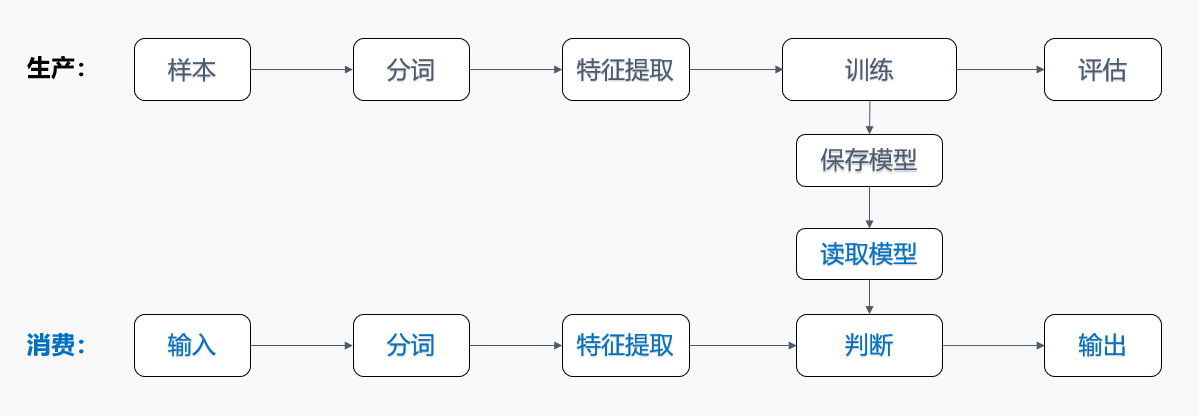一、要解决的问题
问题:常常一些单位或组织召开会议时需要录入会议记录,我们需要通过机器学习对用户输入的文本内容进行自动评判,合格或不合格。(同样的问题还类似垃圾短信检测、工作日志质量分析等。)
处理思路:我们人工对现有会议记录进行评判,标记合格或不合格,通过对这些记录的学习形成模型,学习算法仍采用二元分类的快速决策树算法,和上一篇文章不同,这次输入的特征值不再是浮点数,而是中文文本。这里就要涉及到文本特征提取。
为什么要进行文本特征提取呢?因为文本是人类的语言,符号文字序列不能直接传递给算法。而计算机程序算法只接受具有固定长度的数字矩阵特征向量(float或float数组),无法理解可变长度的文本文档。
常用的文本特征提取方法有如下几种:

以上只是需要了解大致的含义,我们不需要去实现一个文本特征提取的算法,只需要使用平台自带的方法就可以了。
系统自带的文本特征处理的方法,输入是一个字符串,要求将一个语句中的词语用空格分开,英语的句子中词汇是天生通过空格分割的,但中文句子不是,所以我们需要首先进行分词操作,具体流程如下:

二、代码
代码整体流程和上一篇文章描述的基本一致,为简便起见,我们省略了模型存储和读取的过程。
先看一下数据集:

代码如下:

namespace BinaryClassification_TextFeaturize { class Program { static readonly string DataPath = Path.Combine(Environment.CurrentDirectory, "Data", "meeting_data_full.csv"); static void Main(string[] args) { MLContext mlContext = new MLContext(); var fulldata = mlContext.Data.LoadFromTextFile<MeetingInfo>(DataPath, separatorChar: ',', hasHeader: false); var trainTestData = mlContext.Data.TrainTestSplit(fulldata, testFraction: 0.15); var trainData = trainTestData.TrainSet; var testData = trainTestData.TestSet; var trainingPipeline = mlContext.Transforms.CustomMapping<JiebaLambdaInput, JiebaLambdaOutput>(mapAction: JiebaLambda.MyAction, contractName: "JiebaLambda") .Append(mlContext.Transforms.Text.FeaturizeText(outputColumnName: "Features", inputColumnName: "JiebaText")) .Append(mlContext.BinaryClassification.Trainers.FastTree(labelColumnName: "Label", featureColumnName: "Features")); ITransformer trainedModel = trainingPipeline.Fit(trainData); //评估 var predictions = trainedModel.Transform(testData); var metrics = mlContext.BinaryClassification.Evaluate(data: predictions, labelColumnName: "Label"); Console.WriteLine($"Evalution Accuracy: {metrics.Accuracy:P2}"); //创建预测引擎 var predEngine = mlContext.Model.CreatePredictionEngine<MeetingInfo, PredictionResult>(trainedModel); //预测1 MeetingInfo sampleStatement1 = new MeetingInfo { Text = "支委会。" }; var predictionresult1 = predEngine.Predict(sampleStatement1); Console.WriteLine($"{sampleStatement1.Text}:{predictionresult1.PredictedLabel}"); //预测2 MeetingInfo sampleStatement2 = new MeetingInfo { Text = "开展新时代中国特色社会主义思想三十讲党员答题活动。" }; var predictionresult2 = predEngine.Predict(sampleStatement2); Console.WriteLine($"{sampleStatement2.Text}:{predictionresult2.PredictedLabel}"); Console.WriteLine("Press any to exit!"); Console.ReadKey(); } } public class MeetingInfo { [LoadColumn(0)] public bool Label { get; set; } [LoadColumn(1)] public string Text { get; set; } } public class PredictionResult : MeetingInfo { public string JiebaText { get; set; } public float[] Features { get; set; } public bool PredictedLabel; public float Score; public float Probability; } }
三、代码分析
和上一篇文章中相似的内容我就不再重复解释了,重点介绍一下学习管道的建立。
var trainingPipeline = mlContext.Transforms.CustomMapping<JiebaLambdaInput, JiebaLambdaOutput>(mapAction: JiebaLambda.MyAction, contractName: "JiebaLambda") .Append(mlContext.Transforms.Text.FeaturizeText(outputColumnName: "Features", inputColumnName: "JiebaText")) .Append(mlContext.BinaryClassification.Trainers.FastTree(labelColumnName: "Label", featureColumnName: "Features"));
首先,在进行文本特征转换之前,我们需要对文本进行分词操作,您可以对样本数据进行预处理,形成分词的结果再进行学习,我们没有采用这个方法,而是自定义了一个分词处理的数据处理管道,通过这个管道进行分词,其定义如下:
namespace BinaryClassification_TextFeaturize { public class JiebaLambdaInput { public string Text { get; set; } } public class JiebaLambdaOutput { public string JiebaText { get; set; } } public class JiebaLambda { public static void MyAction(JiebaLambdaInput input, JiebaLambdaOutput output) { JiebaNet.Segmenter.JiebaSegmenter jiebaSegmenter = new JiebaNet.Segmenter.JiebaSegmenter(); output.JiebaText = string.Join(" ", jiebaSegmenter.Cut(input.Text)); } } }
最后我们新建了两个对象进行实际预测:
//预测1 MeetingInfo sampleStatement1 = new MeetingInfo { Text = "支委会。" }; var predictionresult1 = predEngine.Predict(sampleStatement1); Console.WriteLine($"{sampleStatement1.Text}:{predictionresult1.PredictedLabel}"); //预测2 MeetingInfo sampleStatement2 = new MeetingInfo { Text = "开展新时代中国特色社会主义思想三十讲党员答题活动。" }; var predictionresult2 = predEngine.Predict(sampleStatement2); Console.WriteLine($"{sampleStatement2.Text}:{predictionresult2.PredictedLabel}");
预测结果如下:

四、调试
上一篇文章提到,当我们运行Transform方法时,会对所有记录进行转换,转换后的数据集是什么样子呢,我们可以写一个调试程序看一下。
var predictions = trainedModel.Transform(testData); DebugData(mlContext, predictions); private static void DebugData(MLContext mlContext, IDataView predictions) { var trainDataShow = new List<PredictionResult>(mlContext.Data.CreateEnumerable<PredictionResult>(predictions, false, true)); foreach (var dataline in trainDataShow) { dataline.PrintToConsole(); } } public class PredictionResult { public string JiebaText { get; set; } public float[] Features { get; set; } public bool PredictedLabel; public float Score; public float Probability; public void PrintToConsole() { Console.WriteLine($"JiebaText={JiebaText}"); Console.WriteLine($"PredictedLabel:{PredictedLabel},Score:{Score},Probability:{Probability}"); Console.WriteLine($"TextFeatures Length:{Features.Length}"); if (Features != null) { foreach (var f in Features) { Console.Write($"{f},"); } Console.WriteLine(); } Console.WriteLine(); } }
通过对调试结果的分析,可以看到整个数据处理管道的工作流程。
五、资源获取
源码下载地址:https://github.com/seabluescn/Study_ML.NET
工程名称:BinaryClassification_TextFeaturize
